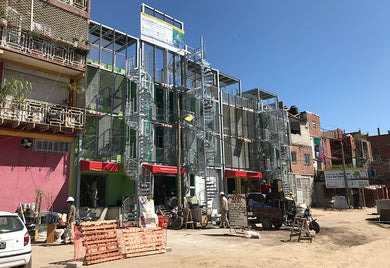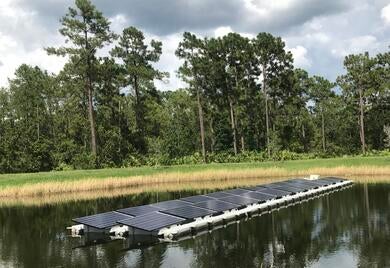
How we incentivize social inclusion through Sustainable Infrastructure? The case of Villa 31
Recently I visited the Villa 31 in Buenos Aires, Argentina. It is a poor and informal neighborhood located at approximately 500 meters from La Recoleta, one of the most sophisticated areas of the Argentinian capital. Despite this proximity, near 45,000 residents at Villa 31 have lived in isolation, not accepted as true “porteños” by their neighbors due to the social and economic characteristic of their community. My hope is that a new development project of sustainable infrastructure in the area changes this scenario. During my visit, I met fantastic people, but I experienced a strong mix of feelings. 20 years ago, I worked on an urban rehabilitation project in Brazil, which provided new homes, electricity, water, and sanitation to hundreds of low income people. By the end of the project, high-level dignitaries from the Government and other entities visited the new homes. One of them approached a woman benefited by the project and asked: “Are you happy? Is your life better?” She looked at him and said: “No, I am much worse off today. Before the project, I lived in a shack, I had no light, no water, no job, but no bills either. Now I have been given this nice house with bills to pay, but I still do not have a job. I do not know what to do”. 20 years after, I still carry this experience with me, even though we have learned a lot about urban development and inclusion projects ever since. The number of success stories has been growing, but its nature remains rather complex and represents a significant challenge to governments, policy makers, and financiers alike. According to an Inter-American Development Bank report: “Poverty-targeted projects that did not include specific objectives to reach excluded populations often reinforced their exclusion”. We must avoid this at all cost and work on the inclusion since the beginning. From Villa 31 to Villa “Thirty and Everyone” Working on sustainable infrastructure is not only about building new houses, but to improve the entire ecosystem around them to mobilize more human and economic resources that help people to break the poverty cycle. Villa 31 is not an isolated case. In Latin American and the Caribbean cities, informal areas can concentrate up to 50% of its habitants, and according the estimates, these number will keep rising. Development processes must include habitants’ perspective. Local communities have a voice, and the fact that we are listening to them makes a huge difference in terms of long-term acceptance, appropriation and viability. During my days at the Villa, I saw the construction taking place and the physical infrastructure being implemented. The work on water, sanitation, accessible roads, energy and electrified systems at Villa 31 is allowing its inclusion into Buenos Aires. More importantly, I saw people smiling and the pride on their eyes not only for the new structures, but for having a voice and being really included. So much that the initiative has been called Treinta y Todos (“Thirty and Everyone”) by Horacio Rodríguez Larreta, Buenos Aires city Mayor. This project has renewed people’s belief that their children would have the opportunity to live a different and better life, which is an essential success factor in such complex situation. Walking the talk at the Villa The feeling when leaving Villa 31 was completely different to what I felt 20 years ago, after our conversation with that woman in Brazil. I saw a high sense of trust and hope, so high that residents are already investing their own capital on improving their homes and establishing new business, such as: restaurants or beauty shops. Complementary initiatives like these are key, considering near 70% of the urban population of Latin America and the Caribbean works in the services sector, according UN-Habitat. A new socio-economic dynamic is developing, and some important external factors are fueling the process forward. The decision to establish a major government office building from the Education Ministry at the Villa provides a strong signal. However, it is not the only one. At the Inter-American Development Bank Group (IDB Group) we firmly believe in ‘walking the talk’, and the construction of the new Argentinian representation in Villa 31 shows it. This is a bold sign of commitment to the country and, more importantly, to the people. As part of the IDB Group, IDB Invest (formerly known as Inter-American Investment Corporation) is mobilizing resources and creating financial tools to stimulate private investments on these projects. Other public and private institutions should learn about the changes at the Villa, and hopefully decide to stand up and support this process too. [gallery type="slideshow" link="file" size="full" ids="7752,7753,7755,7757,7758,7759"] Subscribe to receive more content like this! [mc4wp_form]

Managing risks in an era of stakeholder capitalism
In 2020, firms will be judged less on how they respond to crises and more on how they anticipate them. Engaging stakeholders through technology is an important first step.

Can 'flotovoltaics' be a future partner for hydropower systems?
To address changing paradigms, a new technology has been proposed: hydropower plants that enable solar generation or hybrid hydro-solar systems.

Sustainability makes business sense
Far from being a burden, sustainability is a business opportunity, allowing companies to ensure their continuity and positioning and making them more efficient and profitable.

Corporate governance: A pathway to sustainability strategy
Good corporate governance is fundamental for the sustainable development of the region.

The Floods of 2017: How can the private sector mitigate the impact of natural disasters
There are many theories to explain the current trend of increasing frequency and magnitude of extreme events, but it seems obvious that there is a correlation with increasing average temperatures. Many argue that the world is already experiencing the consequences of climate change and that even if the increase on average world temperature is kept under 2 degrees Celsius, countries will have to adapt to a wider range of natural disasters. During 2017 the world witnessed the occurrence of severe floods from China to Canada. As we wrote this article, Italy was facing its second season of severe flooding. Latin America and the Caribbean was no exception, and Peru was particularly affected by this phenomenon. The floods in the Andean country destroyed 115,000 homes, leaving almost 180,000 homeless, over 110 people were killed, more than 350 were seriously injured, and over 2,500 kilometers of roads have been devastated. The region is particularly vulnerable to the occurrence of floods as it is the most impacted by El Niño. Additionally, due to its high urbanization rate, the impact of floods to cities and urban infrastructure are often devastating. While estimates of necessary annual investments to manage floods in the region vary, given the constraints on fiscal spending, the full burden of this cannot be met by governments alone. Therefore, the private sector has a key role to play, that involves both the development of software as well as hardware. Insurance: A key software for mitigation On the soft side, alternatives to avoid or mitigate the impact of severe floods include flood insurance, payment for environmental services, better flood assessment and warning systems, ecosystems planning, and zoning, among others. All these services can be provided by the private sector through the development of policies and adequate incentive frameworks. For example, unleashing private sector insurers to offer products in Latin America is no easy task but it can bring about a stream of benefits. Insurance is a fundamental component in any strategy of adaptation to natural disasters. As illustrated in a paper by the Global Facility Disaster Reduction and Recovery, flood insurance: Increases resilience against residual risks that cannot be prevented or mitigated Incentivize engagement and investment in risk mitigation measures Reduces pressure on the fiscal budget from natural disasters Private sector participation is driven by a complete shift toward risk-based rates, and more accurate mapping which in turn provide correct economic incentives both in urban as well as in rural areas (agriculture in particular). The private sector can apply innovation and technology to improve early warning systems. The earlier we can identify where storms are likely to hit, the better we can target efforts to minimize damages. In the Netherlands, for example, Siemens has created the concept of “smart levees” by implementing a monitoring system that uses sensors to gauge water pressure, temperature and shifting water profiles. This allows the identification of stretches of levees that are at higher risk of being breached. Innovative solutions for better hardware With respect to hardware, the most obvious opportunities relate to retrofitting and developing infrastructure that is more resilient, and can better perform under extreme conditions. The vulnerability of existing infrastructure was evident during the occurrence of natural disasters in 2017, and the private sector can bring capital, innovation, management systems, and technology. Following hurricane Maria devastation in Puerto Rico, Tesla’s Elon Musk, offered to green and revamp energy generation in the island through the installation of solar systems and high-tech batteries. Bold ideas and innovation will be necessary to assist Latin America and the Caribbean in adapting to the impacts of climate change. In doing so, a vital role of governments is to develop policies and regulatory frameworks that allow the creation of new business models and provide incentives for companies to invest on climate smart infrastructure. For instance, building and financing (public/private) business models for urban drainage transformation in megacities represents a gigantic opportunity to foster investments that will significantly improve the quality of life of millions of urban residents in the region. At IDB Invest we can draw lessons from our vast experience in the region that combined with disruptive technologies, and a menu of financing instruments can offer unique value propositions to our clients. We embrace the opportunity to work with private companies all over Latin America and the Caribbean in the development of innovative models that can contribute to better management of floods and other natural disasters in our countries. Subscribe to receive more content like this! [mc4wp_form]